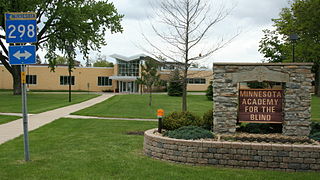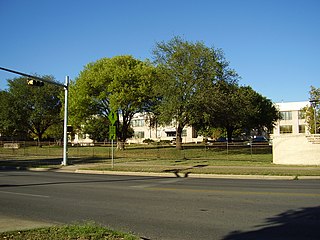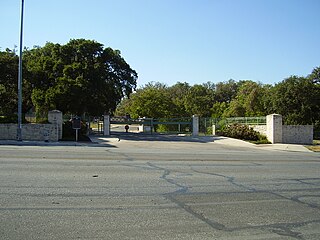Perkins School for the Blind, in Watertown, Massachusetts, was founded in 1829 and is the oldest school for the blind in the United States. It has also been known as the Perkins Institution for the Blind.
The Louisiana School for the Deaf is a state school for deaf and hard-of-hearing students in Louisiana, located in Baton Rouge, the state capital. It was established in 1852 as a joint school for blind students. In 1860, its first purpose-built facility was completed and admired as an elegant monument to philanthropy. The schools were divided in 1898, and in 1908, Louisiana School for the Deaf was renamed.

The Iowa Braille and Sight Saving School was replaced by the Iowa Educational Services for the Blind and Visually Impaired. Vinton, Iowa, hosted the school and continued as host of the state agency that replaced it until 2020.

The Florida School for the Deaf and the Blind (FSDB) is a state-supported boarding school for deaf and blind children established in 1885, in St. Augustine, Florida, United States.
The South Dakota School for the Blind and Visually Impaired (SDSBVI) is a state-supported school located in Aberdeen, South Dakota, which provides services to meet the educational needs of children who are blind, visually impaired, or deaf-blind from birth through the age of 21. SDSBVI has been governed by the South Dakota Board of Regents since 1945.

Minnesota State Academy for the Blind (MSAB) is a public school in Faribault, Minnesota, United States. Its mission is the education and life education of blind, visually impaired, and deaf-blind learners from birth to age 21. The school has a residential program and provides 24-hour programming including Braille, independent travel, assistive technologies, and individualized educational services. Students often have multiple disabilities and come from all regions of the state.

The California School for the Blind is a public educational institution for blind children, K-12, located in Fremont, California. Its campus is located next to the California School for the Deaf.

The Maryland School for the Blind (MSB) is a school in Baltimore for children and youth who are blind or visually impaired, including those with multiple disabilities.

The Texas School for the Blind and Visually Impaired (TSBVI) is a Texas special public school, in the continuum of statewide placements for students who have a visual impairment. It is considered a statewide resource to parents of these children and professionals who serve them. Students, ages 6 through 21, who are blind, deafblind, or visually impaired, including those with additional disabilities, are eligible for consideration for services at TSBVI.

The Virginia School for the Deaf and the Blind, located in Staunton, Virginia, United States, is an institution for educating deaf and blind children, first established in 1839 by an act of the Virginia General Assembly. The school accepts children aged between 2 and 22 and provides residential accommodation for those students aged 5 and over who live outside a 35-mile radius of the school

The Nebraska School for the Deaf, or NSD, was a residential school for Deaf students in kindergarten through Grade Twelve at 3223 North 45th Street in Omaha, Nebraska, United States. Founded in 1869, the school closed in 1998. The school attracted national attention throughout its existence, first for controversial teaching practices and then for its closure.

Texas School for the Deaf (TSD) is a state-operated primary and secondary school for deaf children in Austin, Texas. Opened in 1857 "in an old frame house, three log cabins, and a smokehouse", it is the oldest continually-operated public school in Texas. The school struggled under inadequate funding during the American Civil War, and its aftermath, with the students eating food that they grew themselves on the school farm. In 1951 the State Board of Education assumed oversight of the school.
A sighted child who is reading at a basic level should be able to understand common words and answer simple questions about the information presented. They should also have enough fluency to get through the material in a timely manner. Over the course of a child's education, these foundations are built on to teach higher levels of math, science, and comprehension skills. Children who are blind not only have the education disadvantage of not being able to see: they also miss out on the very fundamental parts of early and advanced education if not provided with the necessary tools.

The New Mexico School for the Blind and Visually Impaired is a state special education school with a residential campus in Alamogordo, New Mexico and a preschool in Albuquerque, New Mexico. It operates outreach programs throughout the state.

The Wisconsin School for the Blind and Visually Impaired (WSBVI) is a state school that specializes in teaching the visually impaired. It is operated by the Wisconsin Center for the Blind and Visually Impaired (WCBVI), a unit of the Wisconsin Department of Public Instruction. Founded in 1849, the school is located in Janesville, Wisconsin.

The Lighthouse of Houston is a private, non-profit education and service center dedicated to assisting blind and visually impaired people in the Houston, Texas metropolitan area to live independently. The Lighthouse serves approximately 9,000 people each year and is a member agency of the United Way of Greater Houston.
The Council of Schools and Services for the Blind (COSB) is a consortium of specialized schools in Canada and the United States whose major goal is improving the quality of services to children who are blind and visually impaired.
Michigan School for the Deaf is a public K–12 school for deaf children in Flint, Michigan. It is under the Michigan State Board of Education.
Virginia School for the Deaf, Blind and Multi-Disabled at Hampton (VSDBM-H), also known as the Virginia School for the Deaf and the Blind-Hampton Campus (VSDB-Hampton) was a school for deaf and blind children in Hampton, Virginia. It was operated by the State of Virginia.












